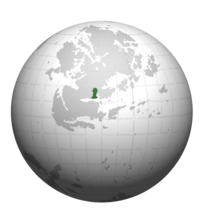Bergenaria: Difference between revisions
Jump to navigation
Jump to search
mNo edit summary |
mNo edit summary |
||
| Line 70: | Line 70: | ||
}} | }} | ||
[[Category:Bergenaria]] | [[Category:Bergenaria]] | ||
Latest revision as of 08:53, 22 May 2023
Bergenaria Reino Federal de Bergenaria | |
|---|---|
| 'Motto: 'Equidad en la Justicia Equality in Justice | |
| Anthem: "¡Oíd, mortales!, el grito sagrado!" | |
 | |
| Capital | Serenno |
| Official languages | Stillian de facto |
| Recognized languages | Stillian and 12 Aromatic languages |
| Ethnic groups | Bergenaran, Anirians, and other diverse groups. |
| Religion |
|
| Demonym(s) | Bergenaro, Bergenario. |
| Government | Federal parliamentary constitutional monarchy |
| Clemente VIII | |
| Sonia Almenares | |
| Legislature | Congreso Nacional |
| Senate | |
| Chamber of Deputies | |
| Unification | |
• Collapse of the Holy Bergenaran Empire | 12 September 1834 |
• Consumation of the Revolución Liberal | 18 September 1834 |
• Start of the Revolución del Cempasuchil | 2 November 1867 |
• Proclamation of the Kingdom | 1 January 1873 |
• Two Thousand Days War | 21 November 1948 |
• Current constitution | 29 December 1971 |
| Area | |
• Total | 238,900 km2 (92,200 sq mi) |
| Population | |
• 2020 census | 29,000,000 |
• Density | 121.3/km2 (314.2/sq mi) |
| GDP (PPP) | 2020 estimate |
• Total | $439,350 million |
| GDP (nominal) | 2020 estimate |
• Per capita | $15,150 |
| Gini (2016) | 33.0 medium |
| HDI (2019) | 0.904 very high |
| Currency | Bergenarian real (BGR) ([[Wikipedia:ISO 4217|ISO 4217]]) |
| Time zone | UTC+6 UTC +7 |
| Date format | dd-mm-yyyy |
| Driving side | right |
| Calling code | +34 |
| Internet TLD | .ber |

